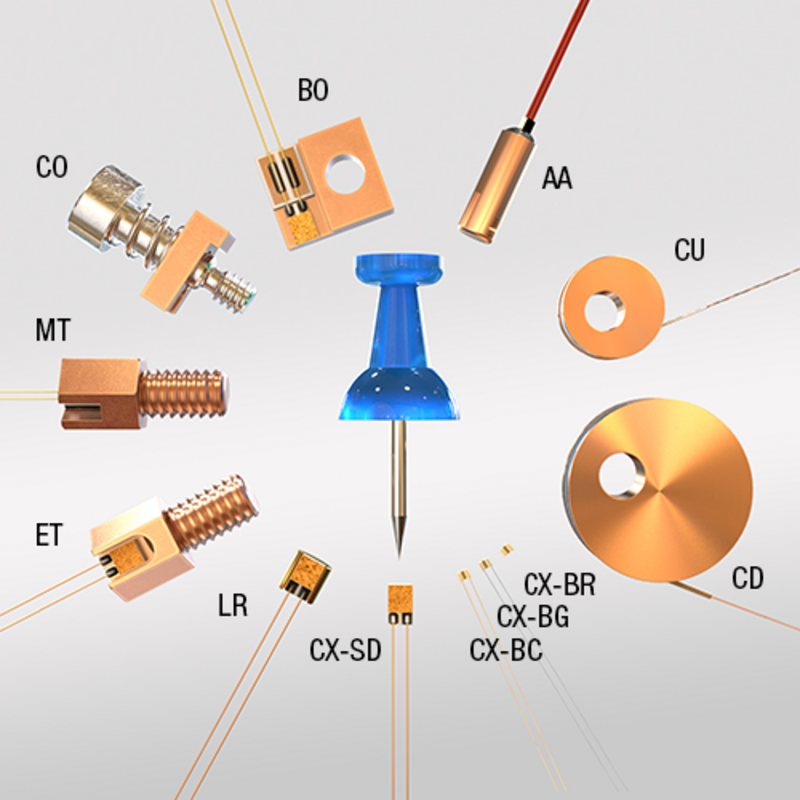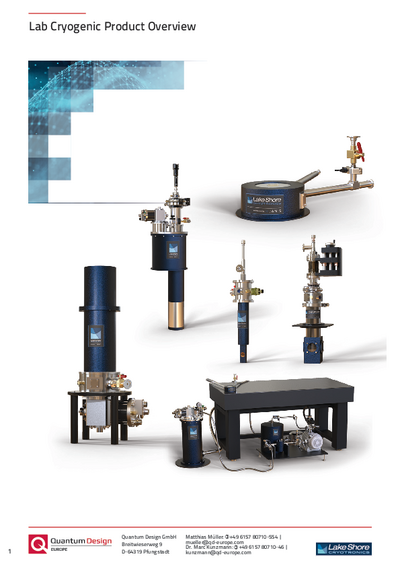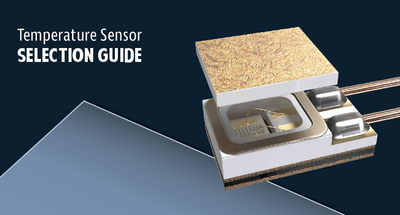Cryogenic Temperature Sensors
From Lake Shore CryotronicsThe choice of the right temperature sensor is essential for an accurate and realistic determination of low temperatures in a cryostat. For this purpose, each sensor can be attributed with an individual set of properties, like temperature range, accuracy and resolution, magnetic resilience, radiation resilience and package options. We are offering Cernox®, Silicon Diodes, Germanium, Rox™ (ruthenium oxide), Platinum, Capacitance and Thermocouple temperature sensors. Depending on the sensor type, different packages are available, like specially designed, bare chips, bolt-down and embedded packages.
Easy product selection for quick inquiries
Takes you to our "Lake Shore Inquiry System" where you can select the sensors, monitors and controllers you need and get an immediate response.
- 0.01K to 1543 K temperature range
- Sensor options for magnetic field and radiation resilience
- Package options to minimize magnetic signature
- Options for vacuum environments
- Accuracies ranging from budget-friendly to world-leading
Further information
|
| Temperature range | Standard curve | Radiation resilient | Performance in magnetic field | Vacuum compatible | Best for |
| Negative Temperature Coefficient RTDs |
|
|
|
|
|
|
| 0.10 K to 420 K |
| Best choice for cryogenics | Best choice above 1 K | Ultra-high | Wide temperature range. Best accuracy and precision in presence of magnetic fields or radiation. Different model to maximize sensitivity at various temperatures. Most popular cryogenic sensor family. | |
| 0.05 K to 40 K | ■ | ■ | Good | High | When sensor interchangeability is desired below 1.4 K or in the presence of moderate magnetic fields | |
| <0.01 K to 40 K | ■ | ■ | Good | High | Temperature measurement below 50 mK | |
| 0.05 K to 100 K |
| ■ | Not recommended | High | Highly stable measurements over long periods of time | |
| Diodes |
|
|
|
|
|
|
| 1.4 K to 500 K | ■ |
| Fair above 60 K | Ultra-high | Great value general purpose sensor for cryogenic applications down to 1.4 K that don't involve magnetic fields or radiation. | |
| Positive Temperature Coefficient RTDs |
|
|
|
|
|
|
| 14 K to 873 K | ■ | ■ | Fair above 30 K | High | Accurate and repeatable measurements above 500 K, up to 873 K. Affordable sensor for applications where temperatures remain above 14 K. | |
| Other |
|
|
|
|
|
|
| 1.4 K to 290 K |
|
| Excellent | High | Highest control stability when in the presence of massive magnetic fields at cryogenic temperatures. Requires a secondary sensor to provide temperature values | |
| 1.2 K to 1543 K | ■ |
| Fair | Ultra-high | Situations where the temperature exceeds 600 C (873 K). Lowest cost sensor for other temperature ranges, but at the cost of significant loss of accuracy | |
| Specialty |
|
|
|
|
|
|
| 20 K to 420 K |
| ■ | Excellent | Ultra-high | Space applications |
Sensor types
Lake Shore offers an extensive range of cryogenic temperature sensors. Check the following summaries to compare their performance and features:
Cernox
Specifically designed by Lake Shore for the demanding requirements of cryogenic applications, Cernox thin film RTD sensors offer extremely consistent high-resolution measurements over a wide temperature range. Due to the materials used and the physical structure of the chip, Cernox sensors are inherently resistant to magnetic-field-induced offsets and damage by ionizing radiation. This makes Cernox the first choice for any traditional cryostat system.
Cernox sensors are also available as a high-reliability variant for space applications.
Silicon Diodes
Silicon diodes are excellent general-purpose sensors with a wide operating temperature range, from 1.4 K to 500 K. As they adhere to a standard curve, silicon diodes are interchangeable. This makes them easier to operate and maintain. Silicon diodes have excellent accuracy and resolution below 30 K, making them an outstanding choice for this range. However, above 30 K, their sensitivity is reduced, so that they are only suitable for purely cryogenic environments.
We offer several mounting options for the silicon diode package to provide flexibility in attaching the sensor to the optimal location of a given experiment or environment.
Germanium
Lake Shore germanium resistance temperature sensors are recognized as Secondary Standard Thermometers because of their excellent long-term stability. However, this advantage comes at a cost. Germanium sensing elements must be mounted without strain inside the package, leaving AA and CD packages the only choices available. Germanium sensors are not useful above 30 K due to reduced sensitivity, but are highly accurate and precise from 1 K down to 0.05 K. Since the germanium sensing element is susceptible to orientation-dependent magnetic offsets, germanium sensors are not suitable in magnetic fields, but for metrology applications like cryogenic calibration they have proven useful.
Rox
The Rox family are all ruthenium-oxide RTDs but have quite different characteristics. In general, they are low-temperature sensors with useful maximum temperatures of 40 K or less. Most Rox sensors are consistent enough to be considered interchangeable, with two accuracy bands available with each sensor model. Rox sensors are not suited for environments with ionizing radiation and experience measurement shifts when exposed to magnetic fields, though these shifts can be compensated for. We offer four different Rox sensors, each of them with different attributes suited for specific environments and applications.
RX-102 A is the most popular Rox model. It is interchangeable, low-priced, and shows sensitivity at liquid helium temperatures.
Platinum
Thanks to their low price, platinum resistance thermometers (PRTs) are very popular. They are useful in higher temperature systems with operating ranges from liquid nitrogen temperatures (77.35 K) to many hundreds of degrees Celsius. Lake Shore's 100 Ω PRTs adhere to the ISO standard temperature curve and have also been characterized for viable operation down to 14 K. This makes them the lowest temperature PRTs available on the market. Above 70 K, PRTs offer high repeatability and nearly constant sensitivity (dR/dT). Platinum resistors are also useful in magnetic field environments where errors approaching one degree can be tolerated. The physical material used in PRTs withstands ionizing radiation. PRTs can be purchased fully calibrated, partially calibrated or uncalibrated.
Capacitance
CS capacitance sensors are highly specialized for the sole purpose of controlling the temperature of cryogenic systems under the influence of very strong magnetic fields. These sensors require partner sensors, such as Cernox, to perform other temperature monitoring tasks. They also require special measurement hardware, like the capacitance option card 3061 for Lake Shore temperature controller models 335 and 336. Despite this added complexity, capacitance sensors are vital if the system temperature must be held extremely stable when under strong magnetic fields, because they exhibit virtually no magnetic field dependence. Once the target temperature is reached, CS sensors are capable of mK control stability above 1.4 K.
Thermocouples
With the widest available temperature range of any sensor type, thermocouple wire is useful for basic temperature measurements on a budget. However, much care needs to be taken when mounting, thermally anchoring and running the wire to the measurement apparatus. Thermocouples also lack measurement accuracy. Thermocouple wires are useful for temperatures exceeding those suitable for platinum sensors. They are sold as wire only and do require additional preparation before use.
Sensor Packages
Lake Shore offers the widest range of sensor packaging options to suit any application. The following summaries allow easy comparison by scoring various characteristics important to the package selection process.
Methods to attach sensors to a surface can be Indium solder, Stycast® 2850 Epoxy, IMI 7031 varnish and CO clamp with Apiezon® N grease or Indium preform. This is a spring-loaded clamp that screws into a 4-40 screw hole.
SD Package - SD
The most popular cryogenic package. Rugged and compact design with excellent thermal contact to the surrounding setup.
- Easy to bond or clamp to flat surfaces
- Package mass is kept low, ensuring fast thermal response times
- Sapphire base for excellent thermal conductivity and electrical isolation
- Alumina body and lid
- Hermetically sealed
- Gold plated to reduce effect of optical radiation
Bare Chips - BR
Bare chips are the package of choice when the smallest possible size and thermal mass are required. This option requires more advanced mounting steps than any other package option.
Bolt-down Packages – BO, CY, CU, CD, CB, AL, AM
A convenient semi-permanent way to attach sensors to an apparatus is bolting it down. However, since the thermal mass of the sensor increases with this method, there is a decrease in thermal response.
Embedded Packages- AA, LR, P
Several packages are small enough to be fitted into a mounting hole. The result is a smaller sensor footprint, however, replacing the sensors is more difficult than with other options.
Specifications
- Thin film resistance cryogenic temperature sensor
- Non-magnetic packages
- Very tolerant to ionizing radiation
- Excellent performance in magnetic fields
- Extremely consistent, wide temperature range
- Temporarily unavailable – please consider Cernox as an alternative.
- resistance temperature sensors
- “Secondary Standard Thermometer”
- High sensitivity at submillikelvin temperatures
- Highly stable and accurate
- Calibrations down to 10 mK
- Dilution refrigerator applications
- Optical shielding improves sensor thermal stability
- Only sensor option capable of measuring below 50 mK
- RX-102A, RX202A and RX-103A
- Standard curve interchangeable
- Good radiation resistance
- Few magnetic field-induced errors
- Useful range of operation from 50 mK to 300 K
- DT-670-SD, DT-670E-BR and DT-621-HR
- Useful temperature range from 1.4 K to 500 K
- Minimal sensor self-heating
- Standard curve for interchangeability
Platinum Positive Temperature Coefficient RTDs
- Conforms to IEC 751 standards down to 70 K
- High reproducibility: ±5 mK at 77 K
- SoftCal™ calibration available
- Non-magnetic packages available (all PT-102 and PT-103 variants)
- Useful upper temperature limit of 873 K
- Interchangeable
- Low cost
- Capable of mK control stability in the presence of strong magnetic fields
- Monotonic in C versus T to nearly room temperature
- Lowest possible offset in magnetic environment
- Requires an accompanying sensor for absolute accuracy and specific measurement equipment capable of capacitance temperature control.
- We recommend to measure the temperature in zero field with another sensor and to use the capacitance sensor as a control element only.
- Type E (Chromel-Constantan)
- Type K (Chromel-Alumel)
- 15 years of full material traceability
- Resistance and sensitivity data
- Gain confidence from our test protocol
Applications
Temperature is a thermodynamic quantity that describes the state of a body. To measure this state, a second body can be brought into contact with the first. This causes the temperature in both bodies to equalize after a certain period.
Thermodynamically, the difference between the temperature of two bodies can always be determined. From this the temperature scale was developed, which refers to the absolute zero point. In the SI system this is the Kelvin scale, which is measured in Kelvin [K] (see box for further scales). Fixed points of this scale are so-called triple points. At these points an atomic species or a compound like water (H2O) is simultaneously present in all three aggregate states, i.e. solid, liquid and gaseous. This is the case for water at 273.16 K. This point is assigned to exactly one pressure and one temperature. The boiling temperature of water (temperature at the transition from liquid to gaseous) varies depending on the pressure and is therefore not clearly defined.
Temperature Conversion Formulas
- degrees Celsius T[°C] = T[K]-273.15
- degrees Fahrenheit T[°F] = T[°C] x 1.8+32
- Degree Rankine T[°R] = T[K] x 1.8
- Degree Réaumur T[°Ré] = (T[K] - 273.15) x 0.8
Thermometers are used to measure the temperature. These are measuring instruments whose measurable data output changes with temperature in a reproducible manner. In general, a distinction is made between primary and secondary thermometers. A primary thermometer is characterized by the fact that its dependence on temperature can be described without unknown and temperature-dependent variables. For example, gas thermometers, acoustic thermometers, noise thermometers and total radiation pyrometers. A secondary thermometer outputs a value that must be calibrated using fixed temperature points. The Platinum RTD (Resistance Temperature Detector) is an example of a secondary thermometer and is based on the change in the electrical resistance of a platinum wire as a function of temperature.
Since primary thermometers are large, slow and expensive, secondary thermometers are used almost exclusively in practice. The secondary thermometers are calibrated using international standards and fixed temperature points. These are defined in IST-90 (International Temperature Scale of 1990) and PLTS-2000 (Provisional Low Temperature Scale of 2000).
Responsible for defining the temperature scale are government authorities such as NIST (National Institute of Standards and Technology), NPL (National Physical Laboratory) and PTB (Physikalisch-Technische Bundesanstalt).
For temperature sensors with extremely reproducible manufacturing processes, tolerance curves are created that indicate how close the temperature curve obtained is to the calibration standard. Examples are Si diodes and platinum thermometers, where it is possible to exchange individual sensors of the same design and still achieve an accurate measurement of the temperature. The degree of accuracy is determined by tolerance bands.
The different temperature sensors (silicon diodes, platinum RTDs and NTC temperature sensors) can be read out by means of a temperature monitor. The temperature controllers go one step further, where the temperature is measured by means of a temperature sensor and then actively set to the desired value by means of an additional heater.
High end applications for the HR series are among others, space telescopes, supercolliders, fusion reactors, research satellites and maglev locomotives.
Downloads
Videos
Contact
| 01 69 19 49 49 | |
| Write e-mail |

Navigation
Categories
Contact
Quantum Design SAS
Avenue de l’Atlantique
Bâtiment Fuji Yama
91940 Les Ulis
France
| Phone: | +33 1 69 19 49 49 |
| E-mail: | franceqd-europe.com |




